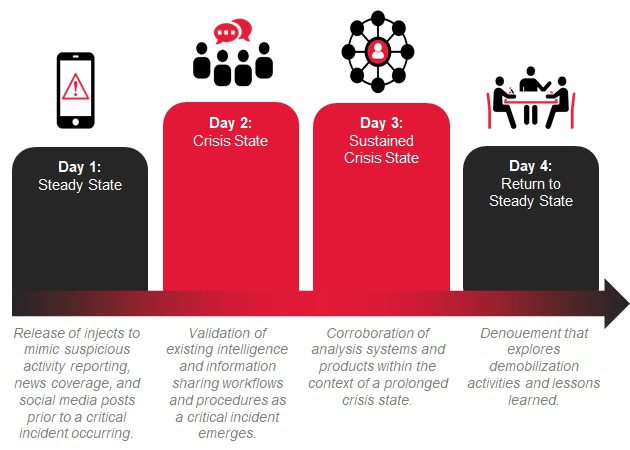Exercises provide stakeholders a valuable opportunity to validate concepts and activities in a no-fault learning environment. In the active threat preparedness field, Hagerty Consulting, Inc. (Hagerty) was grateful for the opportunity to support 38 exercises in 2019 alone. These activities ranged from discussion-based exercises on family reunification and mass casualty crime preparedness to operations-based Special Weapons and Tactics (SWAT) drills and full-scale exercises (FSEs) simulating the operation of a Family Assistance Center (FAC) after an active threat event (in this case, a bombing at a music festival). Hagerty’s exercise design teams take these learning opportunities seriously, understanding that an exercise may be the first, last, or only time participants have to explore concepts and identify gaps before an actual incident (such as an active threat).
While many active threat exercises focus on more tactically-based drills, early in its existence, Hagerty identified a need often overlooked: Testing information and intelligence sharing during critical incidents. With communications breakdowns being identified as an area for improvement following every incident, the need to exercise and understand the interactions that take place within the Information Sharing Environment (ISE) among a wide array of partners is imperative. To address this need, Hagerty developed an innovative, multi-day functional exercise concept.
Enter Hunter Seeker.
The Hunter Seeker Functional Exercise (FE) unfolds over a period of multiple days, enabling participants to work together to build a common operating picture of a potential threat; analyze and synthesize information as a critical incident emerges; and return to steady-state operations following a critical incident.

Figure 1: Example of focus areas of activities over the course of a four-day long Hunter Seeker.
An Exercise Anchored in Supporting the Needs of its Participants
Hagerty’s Hunter Seeker exercise concept is successful due to its three foundational tenets: 1) Scalability in Design, 2) Versatility in Application, and the 3) Creation of a Realistic Play Environment.
Scalability in Design: Every Hunter Seeker exercise is tailored to meet the client’s needs. Hagerty achieves this by conducting interviews and assessments with participating agencies during the early stages of the planning process. These steps allow exercise designers to define key concepts to validate and craft ways to test for gaps in steady state, crisis state, sustained crisis state, and return-to-steady state postures. The result of this design process is a scalable exercise that includes meaningful play for all participants, with the potential to collaborate with whole community stakeholders at all levels (local, state, federal, public, and private).
Versatility in Application: The only limit to how the Hunter Seeker concept can be applied is the client’s imagination. This concept is intentionally versatile and could be applied to key issues, such as active threat, human trafficking, cyberattacks, terrorist attacks, and more.
Creation of a Realistic Exercise Play Environment: Hunter Seeker typically takes place in the players’ actual work environments to ensure players have an exercise experience that feels realistic. Also, Hunter Seeker designers leverage actual technologies whenever possible and develop replicas for key technologies, if needed. For example, Hagerty’s EMSocialSimulation mimics social media platforms so that social media research can be conducted. In one of the more recent Hunter Seekers, Hagerty created over 2,000 social media injects with which players could engage).
The Hunter Seeker design team has also developed a complex cast of characters possessing their own backgrounds, motives, and decision-making pathways that players must work to understand. During the exercise, if players ask the right questions, they earn additional information to help put the pieces of the plot together. This innovative exercise design feature keeps Hunter Seeker an engaging experience.
Case Study: Hunter Seeker within the National Network of Fusion Centers

Figure 2: Fusion Centers with Operational Areas in Six States Have Participated in Hunter Seeker Exercises
The first iterations of this innovative exercise focused on information and intelligence sharing within the National Network of Fusion Centers (NNFC) during a Complex Coordinated Terrorist Attack (CCTA) scenario. These Hunter Seekers involved participation among state and regional fusion centers whose operational areas include Illinois, Kansas, Massachusetts, Missouri, Nevada, and Utah, along with their respective government and private sector partners.

Photo: Simulation Cell (SimCell) team members view a link chart fusion center analysis developed to illustrate relationships between the members of a simulated terrorist organization during a Hunter Seeker exercise designed as part of the St. Louis Regional CCTA Program.
Hagerty is prepared to work with your organization to plan a Hunter Seeker exercise to validate key information and intelligence sharing concepts. To learn more about Hunter Seeker, other services in the Active Threat Portfolio, or the team’s subject matter expertise in this arena, please contact [email protected].
David Schuld is a Deputy Director of Preparedness Programs and Lead for the Active Threat Portfolio at Hagerty. Hagerty began the Active Threat Portfolio in 2015 and has since grown to be a national leader in active threat preparedness. David developed the Hunter Seeker exercise concept in 2016, and since then has worked with a stellar team of subject matter experts and exercise designers to transform this concept into a service. Prior to joining Hagerty in 2015, David worked as a political advisor to the British Army and crisis management advisor for the British Government in the United States (US).
Becky Brocker is a Senior Managing Associate at Hagerty. Becky leverages her background in intelligence analysis and experience as a fusion center supervisor to support the development of Hunter Seeker exercises. Prior to joining Hagerty, Becky served in intelligence and emergency management roles at the Federal Bureau of Investigation (FBI), the DC Homeland Security and Emergency Management Agency’s (HSEMA’s) fusion center, and Argonne National Laboratory.
Althea de Guzman is a Managing Associate at Hagerty. She currently serves as the on-site Regional Program Coordinator for the St. Louis CCTA Program. Althea leverages her previous experience in healthcare and project management to support hospital and healthcare coalition initiatives in the Region. Althea is also currently affiliated with The University of Chicago, teaching emerging professionals to understand complex adaptive systems in emergency management and homeland security.
